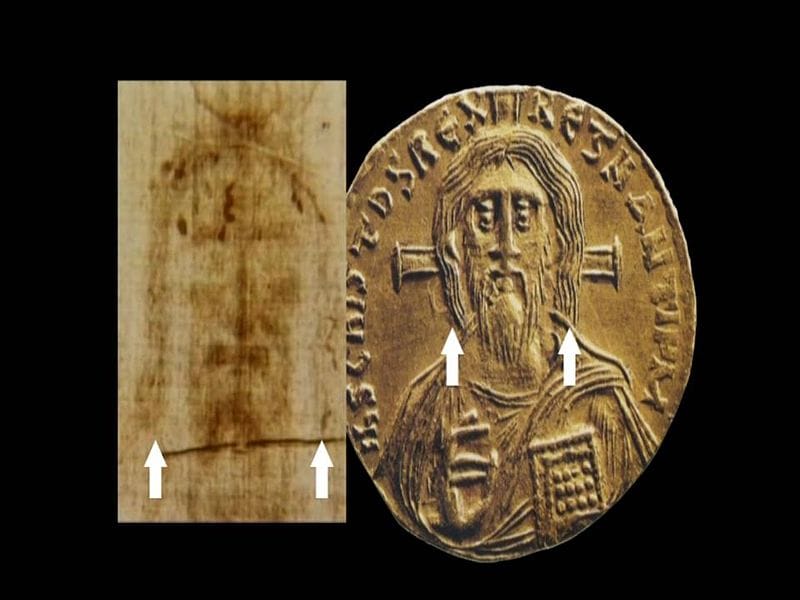New Movie about The Shroud

The Shroud: Face to Face moves audiences. Robert Orlando crosses boundaries to show scientific and historical evidence that “He is risen, indeed.”
The new film documentary, which debuted on Good Friday, is about the Shroud of Turin, “but the Shroud is a significant symbol pointing to something bigger: I want to see Jesus. I want to go where it happened, step into his shoes.”
Orlando, a Princeton, N.J.-based author and filmmaker, began his investigation into the Shroud as a skeptic. Like many Catholics, he was a believer but kind of “rolled his eyes” at stories about the Shroud.
Picture the original Christians present at the founding of the Church: Their founder was arrested, publicly humiliated, and executed—many who believed lost faith. But then, he returned.
And that first clue: His tomb was empty. Was his body stolen? If so, why did the grave robbers not take his valuable burial cloths along with his body? Why leave the expensive woven material behind? The Bible makes clear Jesus wasn’t there, but the cloth remained.
Is the Shroud of Turin objective physical evidence of a man scourged, crucified, and then miraculously resurrected? Blood and a host of clues, including traces of his image, were somehow seared directly into the cloth.
Orlando’s investigation, combining all the significant sources, including science, shows that the Shroud is physical evidence that Jesus and his story are real. New studies show the Shroud wasn’t a forgery. Believers are even offering $1 million to anyone who thinks they can replicate the Shroud.
Bishop Robert Barron read and endorsed Orlando's book, saying it offered a “compelling and convincing account of the single most fascinating relic in the Christian world.”
For Easter Sunday, Barron devoted his entire homily to the Shroud and its “evidence for the resurrection,” recalling the moment the tomb was found empty:
“These strange and beautiful burial cloths opened the door to their belief in the resurrection… I think the same burial cloth that opened the door to faith long ago could perhaps do the same thing today.”
Above: Bishop Robert Barron describes how the Shroud of Turin can “open the door to faith.”
Historian and author Paul Kengor praised the film, writing, “This film really is a must-see at Easter. Imagine: Christ may well have left behind physical evidence of his resurrected body — the very material that his body passed through as he rose again. Think about that. Is that worth considering for an hour and 10 minutes of your time this Easter weekend? Yeah, I’d think so.”
Orlando was one of those skeptics. For years, he avoided requests to investigate the Shroud. Then fate jumped in: his father’s unexpected death moved him to search for evidence.
“There’s really no distance between me and this film,” Orlando said. “I felt the most transparent in this film. Do I know him? Do I know that encounter?”
When the Bible describes the first Easter, “They saw, and they believed?” (John 20:29), could they have discussed finding the Shroud in the burial tomb where Jesus was placed on the first Good Friday?
“I was reading today how many times the Shroud was used for Good Friday,” Orlando said. “You couldn’t use paint to make this. The conclusion from STURP (Shroud of Turin Research Project) confirms not an artist but a real scourged and crucified person.”
Orlando adds: “At least in the case of Jesus and the Shroud, a blast of light passed through the linen and did not burn it, leaving a hair’s width of a detailed, 3D image encoded and configured as a crucified man.”
The film connects all the dots:
“Welcome to the realm where reality meets imagination, where perception and storytelling converge,” Orlando tells us as the documentary opens.
Did photography’s science — and new art — provide us with the seeds to transform our lives, our culture — and history itself?
It’s incredible how much story and information — and how many audiences come together in a one-hour and 15-minute documentary.
Above: The trailer for The Shroud: Face to Face.
The Shroud has a history of converting skeptics who study it. The story goes back to 33 AD. Soon after, the apostle Thasseus brought a cloth to King Abgar, the king of Edesa, and healed the king from leprosy.
In 544 AD, the Shroud was found “hidden in a wall of Edesa.” Soon after, artistic images of Jesus started to look similar, resembling the face we see in the Shroud. But as it was from the Bible through today, “some doubted.”
“When they saw him, they worshipped him; but some doubted” (Matthew 28:17, NIV)
But leave it to new technology to change perceptions. Secondo Pia, in 1898, took the first photo of the Shroud, pioneering the use of then-new technology like flash bulbs.

Similarly, Orlando spent his whole career using film tools to search for the most accurate, compelling picture.
He knows — and shows — how changing a lens alters perspectives and priorities. He’s also a scholar immersed in Biblical studies at the Princeton Theological Seminary.
Orlando, an Italian-American, returns to Italy — and the Holy Land — and takes up a cross, retracing a journey, walking in another man’s shoes.
Could Jesus have left a selfie on the Shroud, marking his resurrection? Proof of life after life and 68 billion watts of power burned into a piece of cloth when no one had any technological power? Watch the film to learn more.
To watch the film or order the book, please visit www.theshroudflm.com.
This story originally appeared at Catholic Way Home (a Medium.com publication)



